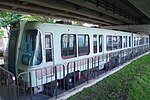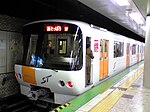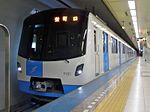Sapporo subway
The urban subway of Sapporo ( Japanese 札幌 市 営 地下 鉄 , Sapporo-shiei chikatetsu , German urban subway Sapporo ) is the metro system of the northern Japanese city of Sapporo on the island of Hokkaidō . It was opened on December 16, 1971 as the fourth subway network in Japan and consists of three lines.
With a total length of 48 km, 46 stations are served. The Namboku Line and the Tōhō Line reach the city's main train station, from the Namboku Line and the Tōzai Line you can change to the tram . The operating times are from 6:15 am to midnight with a journey frequency of 3–4 minutes during the morning rush hour and up to 7 minutes in off- peak hours . The underground is used by 208.4 million passengers annually.
technology
The vehicles on all three lines run on gas-filled rubber tires . The system in connection with the guidance of the trains along a central guardrail is unique in the world for a metro system.
Routes and lines
The routes of the Sapporo subway are operated on a single line. The central transfer point is the Ōdōri subway station.
Namboku Line ( 南北 線 , Namboku-sen , German South-North Line )
Construction of the line began in 1969. It was completed in December 1971, in time for the 1972 Winter Olympics . The 4.4 km long southern section of the initially 12.1 km long route is elevated between the Hiragishi and Makomana stations . It is provided with an aluminum roof to protect the tracks from the heavy snowfalls in winter . After a northern extension on March 16, 1978, the line now has a total length of 14.3 km. Their color code is green, the code letter "N".
The vehicles are guided by a T-shaped guardrail in the middle of the roadway, which also serves to return the traction current. The power supply with 750 V direct current is provided by a busbar . The roadway of the vehicles, each running on two bogies with twin tires, is coated with synthetic resin .
Tōzai line ( 東西 線 , Tōzai-sen , German east-west line )
The current 20.1 km long route was opened on June 10, 1976 with a length of 9.9 km. On March 21, 1982, it was extended by 7.4 km and on February 25, 1999 by 2.8 km. The vehicles with single tires are supplied with 1500 V direct current via an overhead line , the guardrail has a rectangular profile. In the central section the track is coated with synthetic resin, on the outer lines the trains roll on steel. The line identification color is orange, the identification letter "T".
Tōhō line ( 東 豊 線 , Tōhō-sen )
The first two characters are a combination of the districts of Higashi-ku ( 東 ) and Toyohira-ku ( 豊 平 ), in which the ends of this line are located. The color code of the line is blue, the code letter "H".
The third and shortest route, currently 13.6 km, was put into operation on December 2nd, 1988. It received an extension of 5.5 km on October 14, 1994. The power supply with 1500 V direct current comes from an overhead line. The profile of the guardrail is rectangular, and the vehicles that roll on a steel roadway have single tires.
Further expansion
There are plans to extend the Tōhō line by three stations to the southeast. However, a realization is currently rather unlikely, as the number of passengers on the subway in Sapporo is falling slightly.






